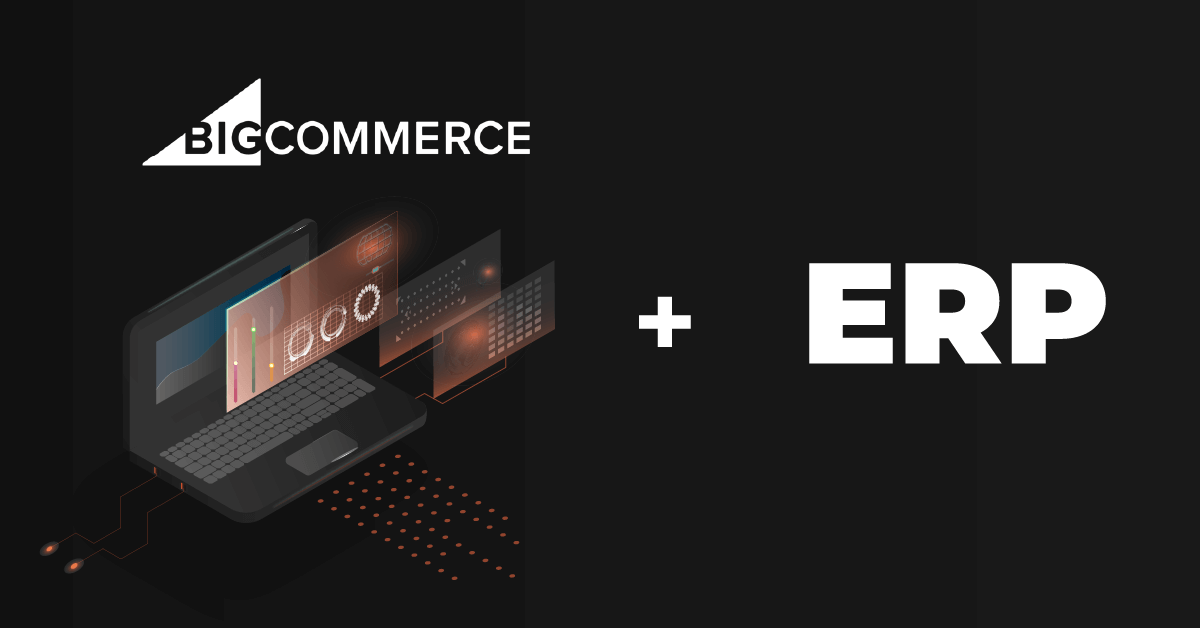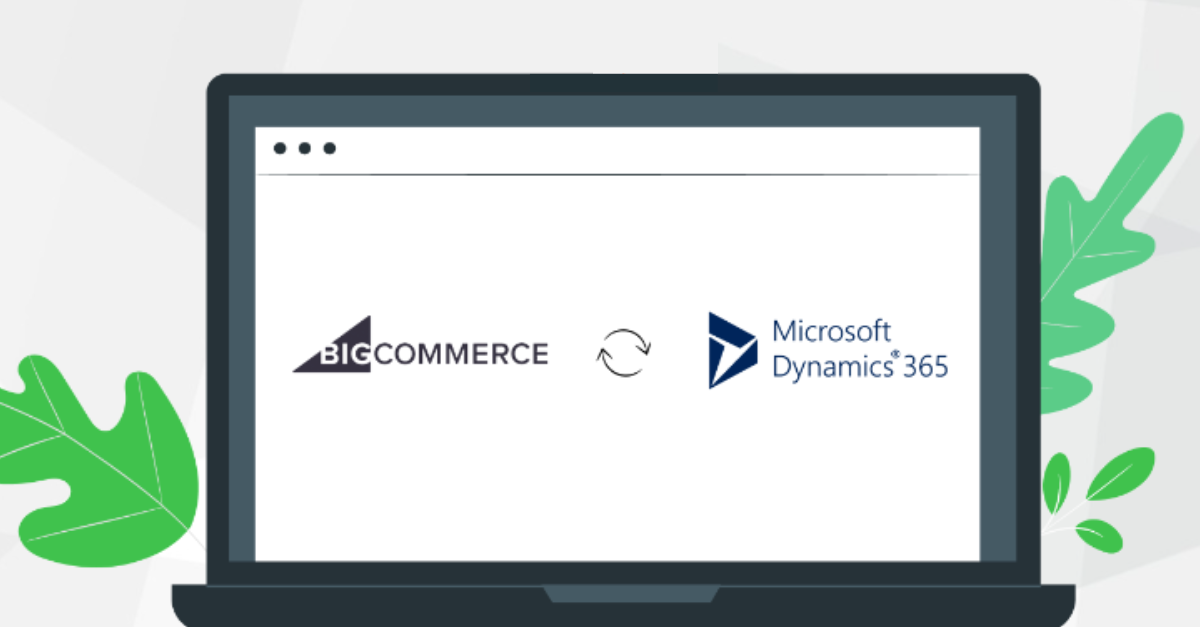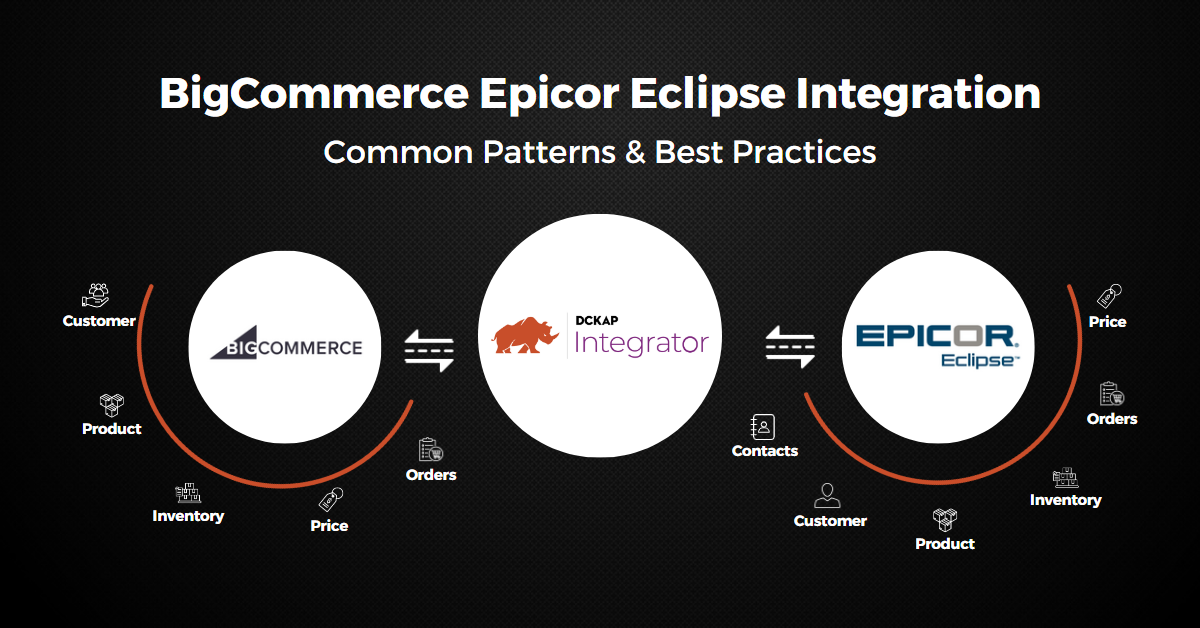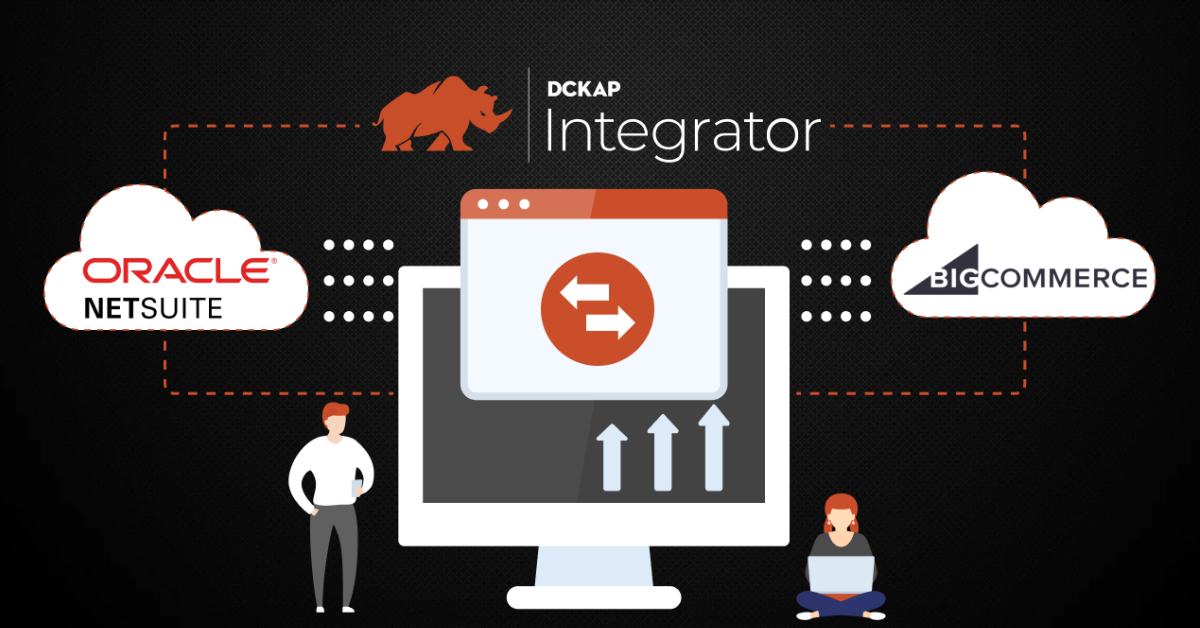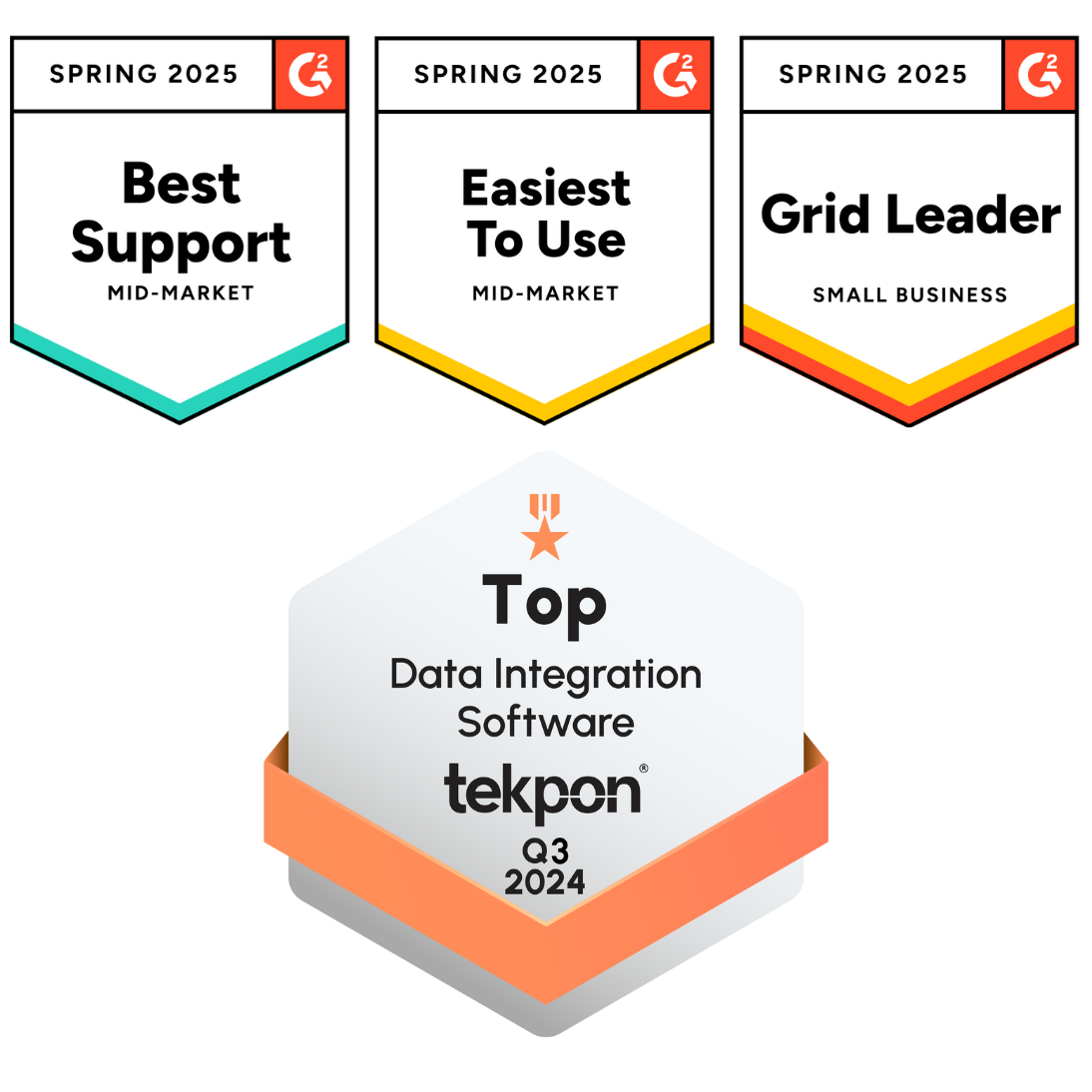Integrating BigCommerce with ERP means that your BigCommerce store and ERP platform communicate automatically without switching between the systems. Successful integration will give you visibility and complete control over data, streamline your sales environment, and elevate customer experience.
Top Ways To Connect Your BigCommerce Store And ERP System
Now, choosing the right integration method is the key to success for your project. The point-to-point (P2P) and enterprise service bus (ESB) models represent more traditional methods, and although some business owners continue to depend on API integrations, iPaaS integration solutions, which are scalable and cloud-based, have emerged as the new favorite. Here’s a complete overview:
1. Native Connectors [Point-to-Point Integration]
Native connectors are pre-built integrations available within BigCommerce or within specific ERP solutions. These are simple plug-and-play solutions that require minimal technical expertise.
How It Works:
- These connectors come as built-in apps or extensions within BigCommerce APP Marketplace or the ERP system.
- You can enable the integration with basic setup and configuration.
- Data flows automatically between your online store and ERP with minimal intervention.
Pros:
- Easy to set up, no coding required.
- Quick deployment, can be up and running in no time.
- Cost-effective for small to medium businesses.
Cons:
- Limited customization options, works best for standard integration needs.
- Not ideal for large businesses that require scalability and flexibility.
- While BigCommerce provides many native connectors, some ERP systems, especially older or highly specialized ones, may not have direct support.
2. Custom API Integration [Point-to-Point Integration]
Custom APIs provide a fully tailored integration solution, allowing businesses to connect BigCommerce with their ERP in a way that meets their distinct integration requirements.
How It Works:
- Your development team (or an external provider) builds a custom API integration from scratch.
- The API fetches, processes, and transmits data between BigCommerce and the ERP system as per your exact business needs.
- The integration can be modified, expanded, or optimized over time.
Pros:
- Highly flexible, can be built to fit any business workflows.
- Can accommodate unique business needs and processes.
- Allows greater control over data handling and automation.
Cons:
- Requires significant investment in development and maintenance.
- Building and testing a custom API takes longer than using pre-built solutions.
- Requires a whole team of technical experts for ongoing support and upgrades.
3. Enterprise Service Bus (ESB)
An Enterprise Service Bus (ESB) is a middleware solution that connects different enterprise applications, facilitating communication between BigCommerce and ERP systems. This method is commonly used in on-premises environments.
How It Works:
- ESB acts as a central hub that receives, processes, and transmits data between multiple systems.
- It helps standardize data exchange and reduce direct dependencies between BigCommerce and the ERP.
- Often used by businesses with multiple interconnected systems that need seamless communication.
Pros:
- Suitable for businesses with complex IT ecosystems.
- Helps manage integrations in a structured, organized manner.
- Can support multiple applications beyond just BigCommerce and ERP.
Cons:
- Outdated for modern cloud-based businesses – primarily suited for on-premises environments.
- Requires a third-party ESB solution and expertise to set up and manage.
- Can be costly and complex for smaller businesses.
4. Integration Platform as a Service (iPaaS)
iPaaS is a cloud-based integration solution that combines elements of all the above methods, offering flexibility and ease of use.
How It Works:
- iPaaS acts as middleware between BigCommerce and the ERP system.
- They support native connectors, custom API integrations, and hybrid approaches, depending on business needs.
- The provider handles all technical complexities, ensuring a hassle-free and seamless integration.
Pros:
- Offers multiple integration approaches in a single platform.
- Requires minimal technical expertise, the provider manages the setup and maintenance.
- Scalable and adaptable, supports growing businesses without requiring major rework.
- Reduces the burden of integration, allowing businesses to focus on operations.
Cons:
- Typically involves a subscription cost.
- Businesses may have less direct control over the integration compared to custom-built solutions.
Also read: Top 5 BigCommerce Integrations and Use Cases 2025
How To Get Started With BigCommerce ERP Integration
To avoid common pitfalls and costly mistakes, take these steps for ERP integration with your BigCommerce store.
Step 1: Set Realistic Objectives
Identify the problems and then go for goal-setting for your integration projects. Make sure you get a buy-in from all stakeholders at this time. When defining goals, consider the following.
- Define the scope, deliverables, and possible limitations
- Outline important milestones as well as the ‘go live’ date
- Determine how you want the final solution to perform
- Define the budget
Step 2: Map your BigCommerce Processes
Map out all your ecommerce processes and make a list of associated applications.
Step 3: Determine Key Data Points
Make sure the data is accurate and up-to-date. Some examples of relevant data include finances, purchase orders, and SKUs (stock keeping units).
Step 4: Identify All Relevant Requirements in Detail
When outlining business processes seek answers to the following questions.
- What details are encompassed in each business operation, such as sales order
- Are there any crucial fields that must be transferred from one system to another?
- From which system does the data originate, and to which system is it transferred or duplicated?
- What is the method of data flow between systems? Who participates in this process? What is the frequency and duration of the data transfer?
- What ERP/accounting software package and its version is the business utilizing? Have there been any modifications to the software? Is the software hosted on-premises or cloud-based?
- Which version of BigCommerce is the business employing? •
- Are any 3PL (third-party logistics) warehouses, inventory, or product information management systems being utilized?
- Are there any business operations that might require integration in the future?
Step 5: Outline Error-Prone, Slow, and Resource-Intensive Processes
Make a note of all the processes that are wasting time, money, and resources. For instance, automating the payout-to-reconciliation process.
Step 6: Choose the Right Integration Solution
When choosing an integration solution for your unique business needs, consider the following factors and capabilities.
- Expertise of the provider
- Custom or off-the-shelf solution
- Scalability and flexibility
- Frequency of integration (real-time, interval, batch, on-demand, etc.)
- Connectivity (pre-built connectors, number of connections, etc.)
- Customer support
Step 7: Calculate ROI
Consider and compare all costs involved.
- The labor cost of manual processes
- Costs associated with human errors, delays, inefficient decision-making, or partial visibility into data
- Total cost of ownership
Why Should You Consider ERP Integration With BigCommerce
Although each business has unique needs, if you are facing any of the following challenges, then ERP integration with your ecommerce platform can be beneficial.
- Challenges while processing an increased number of customer orders: If you use manual data entry processes, hiring new staff to manage the additional workload can prove inefficient and costly.
- Limited scalability and growth: Scaling your ecommerce storefront can look like an impossible target if you rely on people to manage and enter data. Automation and integration can help your team members to shift focus on high-value tasks.
- Inefficient management of inventory: It can be a problem if your inventory isn’t updating in real-time. You may risk selling products that haven’t been stocked or face issues processing returns while managing inventory levels.
- Bad customer experiences: Without integrated processes, you won’t be able to handle inventory and shipping effectively or allow customers to access up-to-date order information.
- Negative customer reviews: Delayed order processing or services can make your customer unhappy, resulting in negative online reviews.
- Ineffective order management (piling backlog of orders): Manual data entry delays order fulfillment, making your customers wait longer for their orders to be shipped.
Also read: BigCommerce NetSuite Integration Explained [+Use Cases]
How Much Does BigCommerce ERP Integration Cost?
Since each project is unique and brings its own set of challenges, the cost may vary. It may be dependent on factors including
- ERP vendor
- Cloud ERP or on-premise
- Number of users
- Number of custom integrations
- Number of other third-party SaaS platforms
- Number of related systems or applications you need to integrate
Simplify BigCommerce ERP Integration with DCKAP Integrator
DCKAP Integrator is a leading iPaaS platform designed for manufacturers and distributors that can connect any number of applications including ERP, CRM, ecommerce, EDI, databases, and others, whether on-prime or in-cloud. With real-time synchronization of data, DCKAP Integrator makes multi-platform integration simple and robust.
Here’s how DCKAP Integrator can expedite ERP Integration with BigCommerce.
- The drag-and-drop feature facilitates excellent project management.
- Custom APIs to integrate multiple systems and applications
- No specialized coding knowledge is required for implementation.
- Plug-and-play flow designers and pre-built connectors make integrations simple and intuitive
- Mapping modifiers enable you to incorporate business Intelligence and accelerate selling without reliance on a technical developer
Transforming eCommerce Business
With DCKAP Integrator, you can offer an exceptional digital shopping experience. Here are some ways you can expect your ecommerce business to transform.
- Improved order processing due to automated data entry. This increases throughput, saves time, and also reduces shipping and order errors.
- Better control over inventory through real-time synchronization. Customers get up-to-date information on inventory levels without any additional support.
- Automated notifications on order shipment with online tracking
- Synchronization between stock and availability, streamlining inventory management
- Reduced collection and rate errors with automated tax compliance
- Scalability without the need for additional resources
- Personalized sales promotions and marketing efforts to potential customers for higher profits
DCKAP Integrator offers transparent and flexible pricing options with no hidden costs and responsive customer service. Plus, you can go live in just four to six weeks.
Real-Life Examples of BigCommerce ERP Integration With DCKAP Integrator
1. Premier Safety
Established in 1950, Premier Safety is a leader in providing technical life-critical safety products and solutions across North America. They built their eCommerce store on the BigCommerce platform and integrated it with Epicor Prelude to streamline backend operations.
How DCKAP Integrator Helped:
- Eliminated manual data entry, reducing errors and saving time.
- Provided real-time visibility into product performance and inventory levels.
- Ensured access to accurate data, enabling better business strategies.
- Freed up employees to focus on business growth rather than administrative tasks.
- Maintained a consistent and efficient flow of data between systems.
Read the full case study here.
2. Maintex
Founded in 1960, Maintex is a leading manufacturer and distributor of janitorial supplies, cleaning chemicals, and equipment in Southern California.
They produce over 500 custom-developed chemical formulas at their City of Industry headquarters.
Why They Needed an Integration:
- Wanted to upgrade their digital operations to keep pace with evolving technology and customer demands.
- Chose BigCommerce as their eCommerce platform but needed a middleware solution to reduce manual data entry.
- Introduced to DCKAP Integrator by BigCommerce to streamline processes.
How DCKAP Integrator Helped:
- Reduced the need for manual corrections and data handling.
- Ensured smooth and automated business processes.
- Delivered reliable insights for planning and forecasting.
- Allowed employees to focus on core business activities.
Read the full case study here.
Final words
The initial step towards successful integration involves assessing your existing systems. Ensure that your ecommerce platform and ERP are updated and operating without issues. When you’re prepared to get started, DCKAP Integrator will be here to help you!
To know more about how DCKAP business can expedite BigCommerce ERP integration, get in touch with us today.
FAQs
What is an ERP?
An ERP or enterprise resource planning refers to software used by a company to manage key business processes and operational functions such as to streamline order management, financial management, accounting, human resources (HR), supply chain logistics management, inventory management, sales, and others. Examples of well-known ERP brands include Infor SyteLine ERP, Acumatica, Oracle NetSuite, Epicor, SAP Business, Microsoft Dynamics, and Sage.
What sort of information can be synced by integrating BigCommerce and an ERP?
Key information such as order and customer data, payments information, inventory, item availability & warehouse data, product data, images and descriptions are some examples of data that can be automated between the two systems. So, whether it’s a company decision-maker, a member of the customer success or sales team, or an operations manager, there is access to real-time, updated, and centralized data at their fingertips.
How does ERP integration improve customer experience and conversion rates?
A seamless integration enhances the user experience by providing accurate pricing, inventory, and custom fields tailored to specific customer needs. Faster processing of orders and automated invoicing contribute to better customer interaction, leading to higher conversion rates and increased traffic to your new site or new storefront.
How do I choose the right integration method for my business?
Selecting the right ERP connector depends on multiple factors, such as business size, scalability needs, and budget. Here are some actionable strategies to help you decide:
- For quick connectivity with minimal effort: Use native connectors if available.
- For complete control and flexibility: A custom API integration is ideal.
- For managing multiple systems within a central platform: Consider an ESB (Enterprise Service Bus) solution.
- For a balance of flexibility and ease of use: An iPaaS (Integration Platform as a Service) service provider is a popular choice among businesses.
What challenges do B2B manufacturers and distributors face in ERP integration?
Some common challenges include:
- Complex product categories: B2B businesses often deal with large catalogs requiring detailed custom fields for pricing, bulk orders, and specifications.
- Multiple sales channels: Integrating ERPs with multiple platforms, such as a new storefront, marketplaces, and direct sales, can be challenging.
- Marketing campaign synchronization: Ensuring that promotions, discounts, and pricing updates are reflected accurately across all channels.
What are some best practices for a successful ERP and ecommerce integration?
To ensure a successful migration of data, follow these best practices:
- Define clear goals: Work with advisors to establish KPIs for order processing, inventory management, and automation.
- Test before launch: Conduct pilot runs to ensure data flows correctly across systems.
- Schedule weekly meetings: Keep all stakeholders informed throughout the entire project lifecycle to minimize errors and delays.
- Ensure compatibility with third-party components: Make sure your ERP system can integrate with essential tools like shipping carriers, CRMs, and accounting software.
- Monitor and optimize: Regularly analyze product status updates, order flow, and customer feedback to improve performance.
Can legacy systems be integrated with modern ecommerce platforms?
Yes, but integrating legacy systems with ecommerce platforms can present common challenges such as outdated APIs, data silos, and limited automation. Middleware solutions or third-party components like iPaaS can help bridge the gap and ensure smooth data transfer.
Contents

